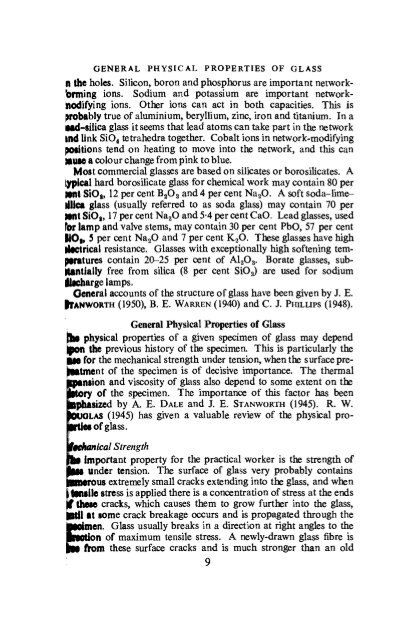Laboratory Glass-Working for Scientists - Sciencemadness Dot Org
Laboratory Glass-Working for Scientists - Sciencemadness Dot Org
Laboratory Glass-Working for Scientists - Sciencemadness Dot Org
Create successful ePaper yourself
Turn your PDF publications into a flip-book with our unique Google optimized e-Paper software.
GENERAL PHYSICAL PROPERTIES OF GLASS<br />
n the holes. Silicon, boron and phosphorus are important networkbrming<br />
ions. Sodium and potassium are important networknodifying<br />
ions. Other ions can act in both capacities. This is<br />
probably true of aluminium, beryllium, zinc, iron and titanium. In a<br />
•ad-si lie a glass it seems that lead atoms can take part in the network<br />
ind link Si04 tetrahedra together. Cobalt ions in network-modifying<br />
positions tend on heating to move into the network, and this can<br />
MUM a colour change from pink to blue.<br />
Most commercial glasses are based on silicates or borosilicates. A<br />
typical hard borosilicate glass <strong>for</strong> chemical work may contain 80 per<br />
Wit Si02f 12 per cent B2Os and 4 per cent NaaO. A soft soda-limelllica<br />
glass (usually referred to as soda glass) may contain 70 per<br />
3tnt St08,17 per cent NaaO and 5-4 per cent CaO. Lead glasses, used<br />
<strong>for</strong> lamp and valve stems, may contain 30 per cent PbO, 57 per cent<br />
WOt, 5 per cent NasO and 7 per cent K26. These glasses have high<br />
ritctrical resistance. <strong>Glass</strong>es with exceptionally high softening temperatures<br />
contain 20-25 per cent of A1203. Borate glasses, sub-<br />
Htntially free from silica (8 per cent Si02) are used <strong>for</strong> sodium<br />
Uncharge lamps.<br />
General accounts of the structure of glass have been given by J. E.<br />
ITANWORTH (1950), B. E. WARREN (1940) and C. J. PHILLIPS (1948).<br />
General Physical Properties of <strong>Glass</strong><br />
[ht physical properties of a given specimen of glass may depend<br />
ipon the previous history of the specimen. This is particularly the<br />
<strong>for</strong> the mechanical strength under tension, when the surface preiMtment<br />
of the specimen is of decisive importance. The thermal<br />
nsion and viscosity of glass also depend to some extent on the<br />
iiy of the specimen. The importance of this factor has been<br />
phasized by A. E. DALE and J, E. STANWORTH (1945). R, W.<br />
LAS (1945) has given a valuable review of the physical proof<br />
glass.<br />
f 0Chanical Strength<br />
important property <strong>for</strong> the practical worker is the strength of<br />
|m under tension. The surface of glass very probably contains<br />
lUMrous extremely small cracks extending into the glass, and when<br />
tensile stress is applied there is a concentration of stress at the ends<br />
)f time cracks, which causes them to grow further into the glass,<br />
Bttil at some crack breakage occurs and is propagated through the<br />
•toiinen. <strong>Glass</strong> usually breaks in a direction at right angles to the<br />
~"~n of maximum<br />
from<br />
9
















